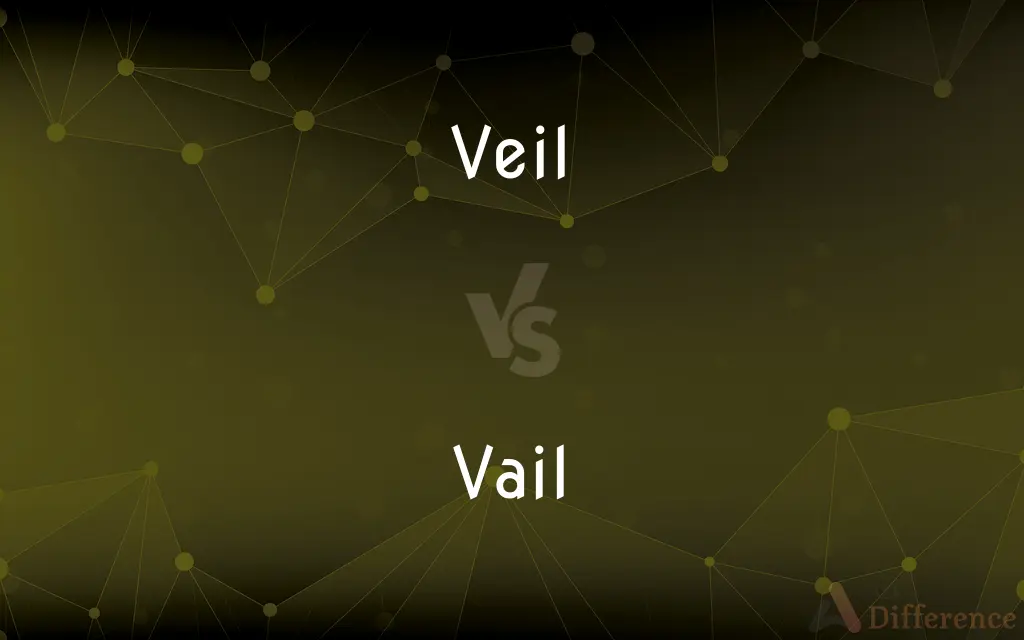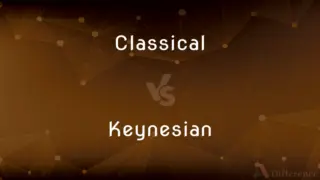Veil vs. Vail — What's the Difference?
Edited by Tayyaba Rehman — By Maham Liaqat — Updated on April 5, 2024
Veil is a piece of fine material worn to cover the face or head, symbolizing concealment. Vail, less commonly used, often refers to the act of taking off one's hat as a sign of respect.

Difference Between Veil and Vail
Table of Contents
ADVERTISEMENT
Key Differences
Veil is traditionally a piece of fabric used to cover the face or head, often for purposes of modesty, privacy, or part of a ceremonial costume. Whereas, Vail is an archaic term primarily used to express the act of lowering or removing one’s headgear as a gesture of respect or submission.
Veils serve various symbolic meanings across cultures, such as purity, mourning, or even protection against evil spirits, while Vail, as a verb, is largely historical and used in literary contexts, indicating deference or homage.
In fashion and weddings, a veil is a common accessory, adding elegance and mystery to the attire. On the other hand, the concept of vailing is almost obsolete, with its usage mostly confined to poetry and old texts where gestures of respect or submission are emphasized.
Religiously and socially, veils can signify religious devotion or societal status, highlighting differences between cultures and personal beliefs. Conversely, vailing, though it carried similar connotations of respect in past societies, is rarely practiced or recognized in contemporary contexts.
Technology and modern interpretations have also transformed the veil into a metaphor for anything that obscures or conceals, such as technology veiling personal privacy. Meanwhile, Vail remains a historical footnote, offering insight into past customs of respect and submission without a modern equivalent.
ADVERTISEMENT
Comparison Chart
Definition
A piece of cloth worn over the head or face.
The act of removing one’s hat in respect or submission.
Usage
Symbolic, religious, and fashion accessory.
Historical and literary, indicating respect or homage.
Cultural Significance
Represents modesty, purity, or mourning in various cultures.
Signifies deference or respect, mainly in historical contexts.
Contemporary Relevance
Widely used in fashion, weddings, and by certain religious groups.
Largely obsolete, with limited usage in modern language.
Symbolism
Can signify concealment, protection, or mystery.
Symbolizes respect, submission, or homage.
Compare with Definitions
Veil
A piece of fine material worn by women to cover the face or head.
She wore a beautiful lace veil on her wedding day.
Vail
To lower or remove one's hat as a sign of respect.
He vailed his hat as the funeral procession passed.
Veil
In religion, a symbol of modesty or piety.
She chose to wear a veil as a sign of her faith.
Vail
(Literary) To yield or give way.
The storm finally vailed at dawn.
Veil
A thing that serves to cover.conceal.or separate.
Mist created a veil over the landscape.
Vail
(Archaic) To surrender or submit.
The knight vailed his banner in defeat.
Veil
To cover or conceal something.
The artist's intentions were veiled in metaphor.
Vail
A sign of respect or deference.
Vailing at the temple was a common practice.
Veil
In biology, a thin layer covering or separating tissues.
The mushroom's cap was covered by a thin veil.
Vail
(Historical) A gesture of homage.
The subjects vailed before the king.
Veil
A veil is an article of clothing or hanging cloth that is intended to cover some part of the head or face, or an object of some significance. Veiling has a long history in European, Asian, and African societies.
Vail
To lower (a banner, for example).
Veil
A length of cloth worn over the head, shoulders, and often the face, especially by women.
Vail
To doff (one's hat) as a token of respect or submission.
Veil
A length of netting attached to a woman's hat or hair worn for decoration or to protect the head and face.
Vail
To descend; lower.
Veil
A length of protective netting worn over the face by beekeepers.
Vail
To doff one's hat.
Veil
The part of a nun's headdress that frames the face and falls over the shoulders.
Vail
(obsolete) Profit; return; proceeds.
Veil
The life or vows of a nun
Assumed the veil.
Vail
Money given to servants by visitors; a gratuity; also vale.
Veil
Any of various cloth head coverings worn by Muslim women.
Vail
(obsolete) Submission.
Veil
A piece of light fabric hung to separate or conceal what is behind it; a curtain.
Vail
To lower, let fall; to allow or cause to sink.
Veil
Something that conceals, separates, or screens like a curtain
A veil of secrecy.
Vail
To lower or “dip” a carried flag or banner in a salute by a forward reducing of the angle of the pike/flagstaff with respect to the ground; in extreme instances, as when saluting a monarch, both the banner and the finial of the pike are allowed to rest upon the ground.
Veil
(Biology) A membranous covering or part, as that on the developing fruiting body of certain mushrooms; a velum.
Vail
To lower a sail, in salute or otherwise.
Veil
To cover with or as if with a veil
Dense fog veiled the bridge.
Vail
To remove as a sign of deference, as a hat.
Veil
To conceal or disguise
A smile that veiled his anger.
Vail
To pay homage, bow, submit, defer (to someone or something); to yield, give way (to something).
Veil
To wear a veil.
Vail
Archaic form of veil
Veil
Something hung up or spread out to hide or protect the face, or hide an object from view; usually of gauze, crepe, or similar diaphanous material.
Vail
Misspelling of veil
Veil
(figurative) Anything that partially obscures a clear view.
Vail
Same as Veil.
Veil
A cover; disguise; a mask; a pretense.
Vail
Avails; profit; return; proceeds.
My house is as 'twere the cave where the young outlaw hoards the stolen vails of his occupation.
Veil
A covering for a person or thing; as, a caul (especially over the head)
A nun's veil
A paten veil
An altar veil
Vail
An unexpected gain or acquisition; a casual advantage or benefit; a windfall.
Veil
(biology) The calyptra of mosses.
Vail
Money given to servants by visitors; a gratuity; - usually in the plural.
Veil
(zoology) velum A circular membrane round the cap of a medusa.
Vail
Submission; decline; descent.
Veil
(mycology) A thin layer of tissue which is attached to or covers a mushroom.
Vail
To let fall; to allow or cause to sink.
Vail your regardUpon a wronged, I would fain have said, a maid!
Veil
(mycology) A membrane connecting the margin of the pileus of a mushroom with the stalk; a velum.
Vail
To lower, or take off, in token of inferiority, reverence, submission, or the like.
France must vail her lofty-plumed crest!
Without vailing his bonnet or testifying any reverence for the alleged sanctity of the relic.
Veil
An obscuration of the clearness of the tones in pronunciation.
Vail
To yield or recede; to give place; to show respect by yielding, uncovering, or the like.
Thy convenience must vail to thy neighbor's necessity.
Veil
That which separates the living and the spirit world.
Veil
(transitive) To dress in, or decorate with, a veil.
Veil
(transitive) To conceal as with a veil.
The forest fire was veiled by smoke, but I could hear it clearly.
Veil
Something hung up, or spread out, to intercept the view, and hide an object; a cover; a curtain; esp., a screen, usually of gauze, crape, or similar diaphnous material, to hide or protect the face.
The veil of the temple was rent in twain.
She, as a veil down to the slender waist,Her unadornéd golden tresses wore.
Veil
A cover; a disguise; a mask; a pretense.
[I will] pluck the borrowed veil of modesty from the so seeming Mistress Page.
Veil
The calyptra of mosses.
Veil
A covering for a person or thing; as, a nun's veil; a paten veil; an altar veil.
Veil
Same as Velum, 3.
Veil
To throw a veil over; to cover with a veil.
Her face was veiled; yet to my fancied sight,Love, sweetness, goodness, in her person shined.
Veil
Fig.: To invest; to cover; to hide; to conceal.
To keep your great pretenses veiled.
Veil
A garment that covers the head and face
Veil
The inner embryonic membrane of higher vertebrates (especially when covering the head at birth)
Veil
A vestment worn by a priest at High Mass in the Roman Catholic Church; a silk shawl
Veil
To obscure, or conceal with or as if with a veil;
Women in Afghanistan veil their faces
Veil
Make undecipherable or imperceptible by obscuring or concealing;
A hidden message
A veiled threat
Common Curiosities
Can men wear veils?
Traditionally, veils are associated with women, but in some cultures and contexts, men may also wear veils for protection or ceremonial purposes.
Can the term veil have metaphorical meanings?
Yes, veil can metaphorically signify anything that conceals, hides, or separates.
What does vailing a hat signify?
It is a historical gesture of respect, submission, or homage.
Are veils worn only for religious reasons?
No, while often associated with religion, veils are also worn for fashion, protection, and cultural traditions.
How do veils vary across cultures?
Veils vary in style, significance, and usage, reflecting diverse cultural beliefs and traditions.
What is the primary function of a veil?
To cover the face or head for various reasons, including modesty, protection, or religious significance.
Can veils be a fashion statement?
Yes, veils are often used as elegant accessories in fashion.
Is vailing still a common practice?
No, vailing as a gesture of respect or submission is largely historical and not common in modern practices.
How does the symbolism of veils differ in religions?
It varies widely, from signifying piety and modesty to mourning or celebration.
Is the act of vailing related to any specific culture?
It is more historical than cultural, associated with medieval European practices.
Are there any legal restrictions on wearing veils?
In some countries, there are laws regarding the wearing of face-covering veils in public spaces for security reasons.
What does removing a veil symbolize?
It can symbolize unveiling truth, clarity, or a transition, such as in a wedding ceremony.
What kind of events are veils commonly worn at?
Weddings, religious ceremonies, and certain cultural events.
Does the term vail have any relevance in contemporary language?
Very little, as it is considered archaic and primarily found in literary or historical contexts.
Is vail ever used in modern English?
Rarely, except in specific literary or historical discussions.
Share Your Discovery

Previous Comparison
Classical vs. Keynesian
Next Comparison
Stir vs. MixAuthor Spotlight
Written by
Maham LiaqatEdited by
Tayyaba RehmanTayyaba Rehman is a distinguished writer, currently serving as a primary contributor to askdifference.com. As a researcher in semantics and etymology, Tayyaba's passion for the complexity of languages and their distinctions has found a perfect home on the platform. Tayyaba delves into the intricacies of language, distinguishing between commonly confused words and phrases, thereby providing clarity for readers worldwide.
















































